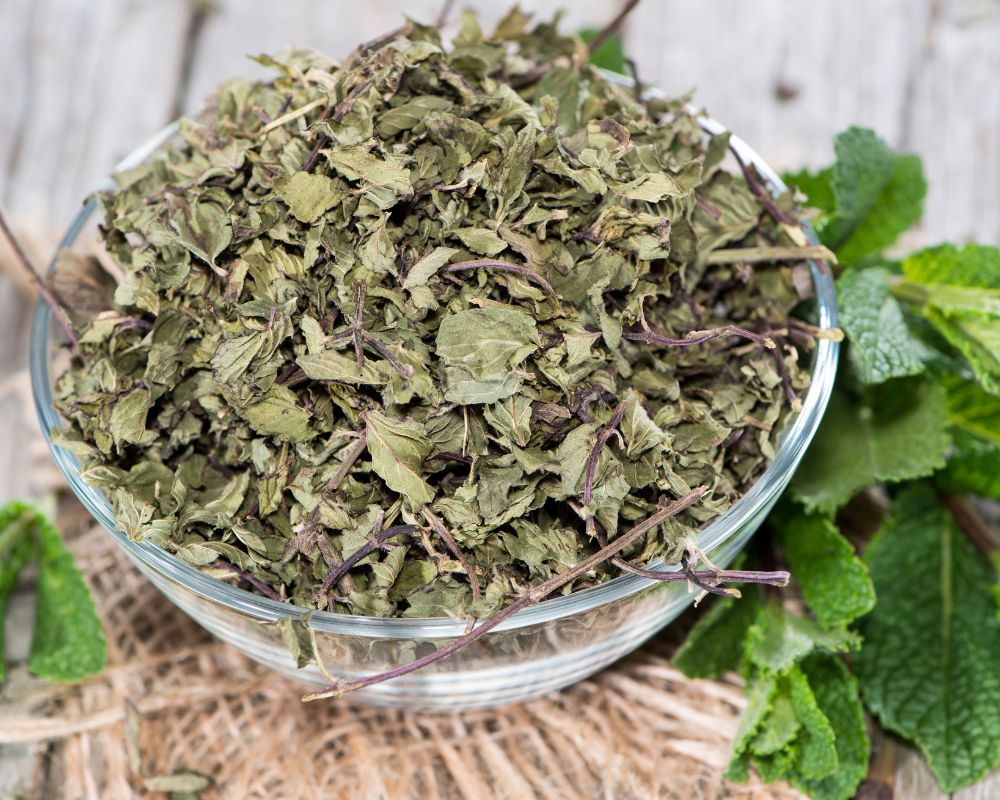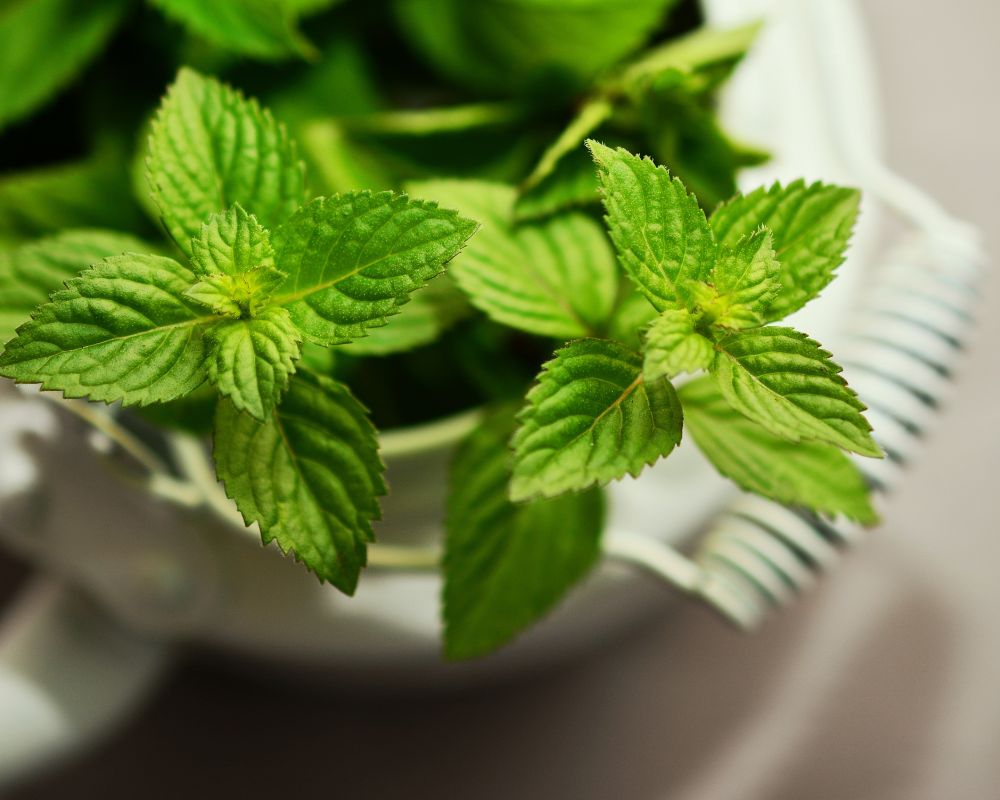Dried mint has a crumbly or crispy texture and is usually green since it comes from green peppermint and spearmint leaves. It has a sweet, woodsy, earthy flavor with hints of lemon and eucalyptus. It's famous for flavoring lamb dishes, such as roasted lamb shanks.
Table of Contents
What is dried mint?

Dried mint is the dehydrated version of fresh mint. It usually contains dried leaves but may also include dried stems.
| Origin | Originated from the Mediterranean in Southern Europe and Southwestern Asia |
| Appearance | Dried mint leaves have a rough, crumbly texture |
| Flavor profile | Has a sweet, woodsy, earthy flavor with hints of lemon and eucalyptus |
Origin
Mint originated from the Mediterranean in Southern Europe and Southwestern Asia before spreading to Britain and later America.
The herb was mentioned in early Greek mythology and real life, where it was celebrated for its nutritional, culinary, and medicinal values.
Mint has now spread to nearly every continent to become naturalized and native to the Mediterranean, Britain, America, Africa, and Australia.
Both fresh and dried mint are common in Middle Eastern and Mediterranean cuisine. It’s used in Greek and Turkish cuisines to flavor lamb, teas, soups, salads, and stews.
Appearance
The mint herb has square stems, toothed leaves, and small white, pink, or purple flowers.
The color of mint leaves and flowers depends on the mint variety. For example, peppermint leaves are dark green, while the flowers are pinkish-lavender. Spearmint has bright green leaves and spiky white, pink, or purple flowers.
Dried mint leaves have a rough, crumbly texture.
Flavor profile
Dried mint has a sweet, woodsy, earthy flavor with hints of lemon and eucalyptus. It has a cooling menthol-like fragrance.
Nutritional Benefits of dried mint
Dried mint has many health benefits:
- It contains minerals and vitamins
- It is a source of antioxidants, fiber, iron, folate, manganese, and vitamins A, C, and E
- Menthol relaxes digestive system muscles, which helps relieve irritable bowel syndrome
Minerals, such as calcium and phosphorus, and vitamins A, C, D, and E in mint dried mint leaves help to improve the immune system and protect body cells from damage.
Dried mint leaves also contain salicylic acid, which helps reduce blemishes and acne. The anti-inflammatory and antioxidant rosmarinic acid in mint leaves helps reduce allergies and asthma by blocking allergens.
Is dried mint as healthy as fresh?

Dried mint is as healthy as fresh mint. The main differences between the two are the moisture content and the stronger, more concentrated fragrance of dried mint.
Despite the negligible difference between dried and fresh mint leaves, you should use the fresh version whenever possible. The drying process leads to the inevitable loss of some minerals and nutrients, especially vitamins A, C, and E.
What is dried mint good for?
While dried mint is excellent as a spice, it’s also good for medicinal applications, such as:
- The antioxidants in mint promote hair growth and prevent hair loss
- Mint has antibacterial, anti-inflammatory, and antifungal properties that are effective in skincare
- The mint essential oils help calm the mind, which reduces stress and depression
- Peppermint water applied after breastfeeding is great at reducing nipple pain
How to use dried mint?
You can use dried mint as a spice to add the characteristic menthol aroma and a sweet, woodsy, earthy flavor to many dishes, such as:
- Desserts
- Cocktails like mojito
- Herbal teas (mint teas)
- Yogurt sauces
- Lamb
- Salads, such as Turkish cacik, a yogurt and cucumber salad
- Casseroles
- Mint-flavored ice cream
- Cooked vegetables
- Mint sauce, a spice blend featuring mint, vinegar, salt, castor sugar, and boiled water
- Spice rubs for meat and poultry
How to dry mint?
Making your own dried mint in a dehydrator is the best drying method to retain the highest aroma levels possible. Below are easy step-by-step instructions for drying mint at home:
- Remove unwanted mint leaves from your batch, such as rotten, heavily spotted, or wilted leaves.
- Rinse the remaining high-quality leaves in cold water for 1-2 minutes to remove dust, soil, and insects.
- Dry the leaves using paper towels or kitchen cloths to reduce drying time in the dehydrator. Dry with a salad spinner if you have plenty of mint sprigs.
- Remove the stems, if preferred.
- Place the leaves on dehydrator trays in single layers without overlapping or overcrowding.
- Turn on your dehydrator and set it to 100°F-105°F for the mint to dry in 2-5 hours.
- Monitor the drying process after two hours and regularly every 15 minutes afterward.
- Remove the mint from the drying rack when it becomes crumbly and crispy.
- Allow the mint to cool briefly, and immediately pack it into airtight containers, preferably glass jars. Put the dried herb in several containers to prolong its shelf life. Monitor the dried mint for 5-7 days before long-term storage if it doesn’t get moldy, sticky, or form condensation in the jars.
Can you rehydrate this dried herb?
Dried mint can easily be rehydrated.
To rehydrate your dried mint, follow the steps below:
- Pour dried mint leaves into a small bowl containing warm water. Ensure all the leaves are completely covered by water.
- Cover the bowl to prevent vapor loss, and leave the leaves to soak in the water for 10-15 minutes.
- Use a fine strainer to strain the steeped water.
You can use wet leaves or concentrated steeping water, depending on your dish.
If preparing a cooked dish, you don’t have to rehydrate your dried mint beforehand. Add it directly to the cooking dish to save prep time and maximize the aroma and flavor of the herb.

